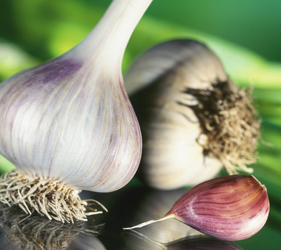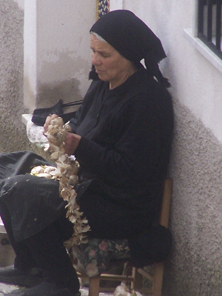Garlic
by Gail Faith Edwards
The culinary uses of the “stinking rose” are rivaled only by its health benefits.
 The little fruit and vegetable store in our Italian village has large, beautiful braids of garlic bulbs hanging from the walls. They smell so fresh and wonderful, blending with the vibrant colors and aromas of all the other beautifully displayed foods to make a visit there a high point of almost any day. The oranges all have fresh leaves on them, like they were just harvested that morning. The eggplants are plump and big. The fleshy black and green olives floating in a heavenly brine are absolutely irresistible. The little fruit and vegetable store in our Italian village has large, beautiful braids of garlic bulbs hanging from the walls. They smell so fresh and wonderful, blending with the vibrant colors and aromas of all the other beautifully displayed foods to make a visit there a high point of almost any day. The oranges all have fresh leaves on them, like they were just harvested that morning. The eggplants are plump and big. The fleshy black and green olives floating in a heavenly brine are absolutely irresistible.
Everything is organically grown and of amazing quality! And it’s not just being in the store that makes a visit there so special. It is also the experience of walking there and back. Of course, one has to remember to go before 1:30 or after 5:30 or the store will be closed. Everyone in our village takes a siesta after their mid-day meal. Afternoons find the San Giacomese either eating a big happy dinner with their extended family and neighbors or sound asleep until the evening church bells ring.
The women often sit outside their houses on little wooden chairs set in a sunny spot and do their work with foodstuffs, like braiding garlic or trimming freshly cut greens. I usually stop and sit with them while they work. I enjoy the laughing and joking that the women do together. I feel pleasure when they welcome me affectionately by pinching my cheek and kissing me on both sides of my face. And I especially appreciate their generosity when they show up at my door unexpectedly with a plateful of freshly made zepoli, a nice bottle of home-made wine, a block of cheese or a few bulbs of their wonderful garlic.
Garlic – Allium sativum – along with other members of the Allium family of plants, gets its biting aroma from a sulfur-rich, volatile oil called allicin. This substance is primarily responsible for the power of garlic and onions to kill bacteria and stimulate circulation. There are over six hundred species of Alliums, distributed all over Europe, North America, Northern Africa and Asia. The plants are used as ornamentals, vegetables, spices and as medicine. Garlic enjoys a history that appears to come from the mists of time, and it surely was one of the earliest spices used to liven up the taste of food.
Medicinal Uses
The edible Alliums contain iron, are a rich source of vitamins and minerals, and offer a host of other health promoting properties. Garlic is not only antibacterial, but antiviral, antiseptic, antiparasitic, immune-stimulating, antispasmodic, hypo- tensive (lowers blood pressure), diaphoretic (promotes sweating) , antiprotozoan, antifungal and cholagogue (stimulates the flow of bile.)
 |
Pliny, the Roman naturalist, thought garlic was good for almost every known affliction. Galen, the Greek physician, called it a cure-all. Ancient Romans and Greeks considered garlic a symbol of strength and courage and it was regularly consumed by their athletes, workers and soldiers. The Egyptians held garlic in high esteem and recorded over two hundred medicinal uses for it. Garlic depictions have been found on Egyptian tombs dating back to 3200B.C. The ancient Hebrews considered garlic to enhance virility and said that “it keeps the body warm, brightens the face, increases semen, kills parasites, fosters love, and removes jealousy.” The Israelites were so fond of garlic they referred to themselves as “garlic eaters.” So you can rely on the regular use of garlic to keep your body functioning optimally.
Repeated studies have shown that garlic benefits the heart and circulatory system. It will help keep that all-important and vital organ well toned, help keep blood pressure down, and help lower cholesterol.
Garlic is rich in antibiotic powers and is strengthening to the immune system. It is active against both gram positive and gram negative bacteria, including Shigella dysenteriae, Staphylococcus aureus, Pseudomonas aeruginosa, Candida albicans, Escherichia coli, Streptococcus spp., Salmonella spp., Camphylobacter spp., Proteus mirablis, and Bacillius anthraxis. Garlic is also active against herpes simplex, influenza B, HIV, and many other serious illnesses. Note that it is active against the food-borne pathogens so often found in commercial foods: Shigella, E. coli, and Salmonella. Garlic kills bacteria in the gastrointestinal tract immediately on contact. To treat an active intestinal bacterial infection, consume lots of raw or cooked garlic or take garlic capsules.
As an antioxidant, garlic is a benefit to those dealing with cancer. Dr. Richard Rivlin of the Sloan-Kettering Institute makes a case for eating a couple of cloves each day to reduce your risk of developing cancer. The American Institute for Cancer Research agrees, adding that garlic may be especially effective for warding off cancer of the esophagus. And Dr. John Milner at Penn State believes that consuming garlic leads to a lower risk of colon cancer.
Garlic stimulates the isles of langerhans (pancreatic cell clusters), increases insulin production, and lowers blood sugar, thus aiding diabetics in the control of this debilitating disease.
Garlic also helps increase the synovial fluids, and so is an ally for those dealing with arthritis. The sulfur in garlic helps break up the crystallization of uric acid in the joints, thus aiding in the relief of gout.
Garlic stimulates the brain and has a positive effect on brain functioning, helping to keep us alert and energized. Scientists have found that garlic’s anti-aging properties not only slow the destruction of brain cells, but also cause new brain neurons to branch out. Eleanor Roosevelt is said to have eaten three chocolate-covered cloves of garlic every day to help keep her memory sharp.
Cooking With Garlic
An old recipe to keep the mind sharp includes one pound of garlic, ground and added to a jar with the juice of twenty-four lemons. Leave this covered for one moon cycle, then take one teaspoon each night.
Less exotic is to chop some into your salad, as my mother always did, or throw it, simmered in olive oil, over noodles and sprinkle with parsley. Paula Wolfert, an expert on Mediterranean cuisine, thinks garlic and olive oil is one of the greatest discoveries in culinary history. She says, “When garlic and olive oil are combined in a creamy suspension, something sublime is born.”
Believe it or not, a meal heavy with garlic is said to “provoke eroticism.” Garlic is used to season the foods of almost every culture in the world. Add it to salads, soups, stews, sauces, rice, noodles, vegetable dishes, pickles, fish, poultry, and meats.
On Christmas Eve, my Italian Catholic neighbors traditionally enjoy a meal of fish and pasta. My grandmother always prepared a spaghetti dish covered with garlic simmered in olive oil with a bit of parsley on this special night. We call this dish Aglio e Olio. My mother made this same dish every Christmas Eve and now I serve it to my family. I have no doubt that my kids will all prepare Aglio e Olio for their families when the time comes. Of course, there is no need to wait until Christmas to enjoy this delightful dish. It is simple and easy to prepare and eat all year round.
Click here for directions for making Aglio e Olio and a few other tasty recipes using garlic.
Cultivating Garlic
Growing garlic is easy. You can easily grow a winter’s supply in three-by-five-foot garden bed. The soil needs to be fertile, so the addition of some nourishing compost will ensure you get a good harvest. The bulbs are usually planted in the fall, around mid-October, but I have also planted garlic bulbs very early in spring, just as soon as the ground could be worked and they grew perfectly fine, though perhaps not quite as big.
Fall-planted garlic shoots are among the very first of the spring greens to emerge. Called green garlic or ramps, they are a bit thicker than chives and can be eaten cooked or raw. These young garlic greens make a very welcome, enlivening addition to any salad. They taste tender and sweet and are a wonderful spring tonic. During the growing season, garlic must be kept well weeded and it appreciates watering during dry spells.
Here in New England, where I live when I’m not in Italy, we can usually expect to harvest our garlic in mid to late July. When about half of the leaves are drooping and turn brown, it’s time to dig. After you’ve taken the bulbs up from the ground, being careful not to hurt them as you do so, tie six or so in a bunch and hang them in a dry place to cure for a couple of weeks. We usually set aside the biggest ones for the next planting and eat, store or sell the rest. Garlic bulbs have a long shelf life. We are usually still eating garlic we harvested the previous fall at the end of April! The softneck varieties last for nine months or so, the hardnecks not quite as long.
Gail Faith Edwards is a compassionate and highly knowledgeable herbal educator with 30 years experience serving as a community herbalist. She offers herbal consultations and has taught classes and workshops in India, Italy, and across North America. Gail is one of ten women featured in “Maine Women—Living on the Land” a Photographic Installation by Lauren Shaw. This exhibit, which has traveled throughout the United States, celebrates the lives and environments of ten Maine women who have lived most of their lives in close harmony with the land. Her Blessed Maine Herb Farm is located on a beautiful ridge-top in rural Maine, where they grow over an acre of medicinal herbs, flowers, and vegetables using natural farming methods. These MOFGA-certified organic gardens are open to the public, by appointment, during the growing season. For details, visit www.blessedmaineherbs.com.
|

